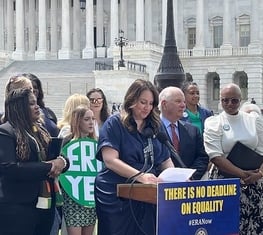Redistricting Watch: What the For the People Act Means for Redistricting
This blog post was written by Maddie Schumacher and Dylan Vargas.
In a late-night vote on March 3rd, the House of Representatives passed, for a second time, the historic democracy reform package, the For the People Act (HR1). With the intent to make voting easier, more accessible, and modernized, the For the People Act is the democracy reform bill the American people want and deserve. It will put power back in the hands of American voters, expand voting rights, and ensure a stronger and more inclusive democracy. But the bill doesn’t just make voting simpler—it makes it fairer by outlawing the racial and partisan gerrymandering that keeps power in the hands of the few.
Gerrymandering is the process by which state legislators manipulate district maps to favor or disfavor a group of voters based on political affiliation or race. Certainly, every citizen gets one vote, but gerrymandered maps dilute voters’ ability to elect their candidate of choice.
The impact of gerrymandering makes the redistricting process increasingly flawed, corrupt, and undemocratic. Over the decades, we have seen the consequences of heavily gerrymandered districts that prioritize political power over representation. The For the People Act sets out to change that by instituting independent commissions, standardizing criteria, and requiring transparency. These reforms would rewrite the rules of the electoral process and ensure that voters choose their representatives, not the other way around. Now that the For the People Act has passed the House, it’s critical that the Senate move immediately to pass the bill.
Independent Redistricting Commissions
In most states, redistricting is controlled by state legislatures, which, by nature, means that the maps are manipulated to favor the people in power who draw them. This status quo is unfair, biased, and undemocratic. We shouldn’t be putting map-drawing power in the hands of the people whose power is map-determined. There is little to no incentive for legislators to draw fair and representative maps that effectively diminish their power.
Fortunately, the For the People Act challenges this system. The bill would transfer redistricting power from legislatures and authorize independent redistricting commissions to draw the maps instead. These commissions would have an equal number of Democratic, Republican, and Independent commissioners to balance political power and ensure no one party dominates the process.
Putting control of redistricting in the hands of independent commissions would limit the incentives that lead to gerrymandering, and would ultimately create more representative maps.
Standardized Criteria
There are also no standard criteria used across all states to determine and draw districts. Across the country, we see countless variations in the criteria considered when drawing maps. This makes the process unnecessarily complicated, inaccessible, and vulnerable to manipulation.
Currently, state legislatures can change map drawing criteria unilaterally and arbitrarily as it suits them. The For the People Act would end this by establishing standardized criteria to govern redistricting in all states and ensure that all maps meet basic standards of fairness. These criteria include greater protections for racial, ethnic, and linguistic minorities, a ban on partisan gerrymandering, and a mandate to protect communities of interest.
With these criteria in place, the districts drawn will be inherently fairer, more representative, and formulated with less bias.
Transparency
In recent years, partisan or racially gerrymandered maps were drawn in secrecy, behind closed doors. The only way to have a truly accountable redistricting process is to make it open to the public.
The For the People Act introduces federal transparency provisions into the redistricting process for the first time. These include requirements that redistricting meetings be open to the public, have public input hearings to allow community voices be heard, allow publicly submitted maps, and make all data files used to draw maps accessible. It’s really that simple: the more people who are aware of and informed about how redistricting is done, the more representative and inclusive our maps become.
The For the People Act’s reforms to the redistricting process will go a long way towards ending gerrymandering. They challenge inherent partisan bias, racial discrimination, voter suppression, and rampant secrecy in the current redistricting process. Our communities will once again feel heard and be valued under the fair and equitable redistricting process provided by the For the People Act.
It is time to fight for our democracy in the Senate. Contact your Senator* to ensure they support the For the People Act. The American people deserve a democratic redistricting process led by the people and for the people.
*For DC residents, we continue working towards full voting representation in the U.S. Congress. To join our fight for D.C. statehood, click here
The Latest from the League
This bill will make elections fairer and put power back in the hands of the American people.
This blog is the first of a series of blogs about redistricting and the different issues it impacts.
People Powered Fair MapsTM is a national redistricting program of the League of Women Voters focused on creating fair political maps nationwide. The program includes actions in all 50 states + D.C.
Sign Up For Email
Keep up with the League. Receive emails to your inbox!
Donate to support our work
to empower voters and defend democracy.





